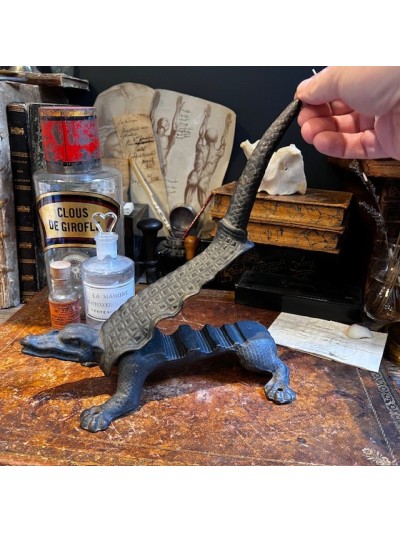
Antique hypodermic winged syringe of PRAVAZ - End of the...
Hypodermic Pravaz winged syringe - 19th century
Syringe in it's case
not functional

















Crocodile - Pharmacy corkscrew in cast iron
Beautiful patina.
19th century
Pharmacy cork crusher in the shape of a crocodile
Beautiful patina.
Cast iron - 19th century
The cork crusher was invented around 1830 and was used throughout the 19th century until the early 20th century. It allowed pharmacists to compress and soften corks before inserting them into bottles containing medicine.
Cork crushers are often found in zoomorphic forms, particularly in the shape of a crocodile, which is also the other name for a cork crusher.
Length: 28.5 cm
It weighs 2.2 kg!
Before these objects appeared, apothecaries or pharmacists chewed the corks themselves to insert them into bottles... Hence the term ‘cork chewer’in french...
Hypodermic Pravaz winged syringe - 19th century
Syringe in it's case
not functional
Antique metal pharmacy display for 12 bottles
Apothecary
SOLD ON ITS OWN WITHOUT VIALS
Teinture de Capsicum
Antique pharmacy bottle - Apothecary
Antique drum microscope
With its wooden case containing 1 brass clamp and 2 preparation slides
XIXth century - inscription under the case dated 7 or 8 May 1853
Iodine tincture
Antique pharmacy bottle
Apothecary vial
EMPTY
Delphinium staphisagria - Stavesacre
Pharmacy jar - Herbalism - Apothecary bottle
Late 19th century, early 20th century.
Teinture de Cantharides - POISON
Lytta vesicatoria - Spanish fly
Antique blue glass pharmacy bottle - Apothecary
Early 20th century - Blown glass.
REVEL mint alcohol in Lyon
Antique pharmacy bottle
86° alcohol!
Eau d'Arquebuse de Notre-Dame de Bon Secours
Antique pharmacy bottle - Apothecary
Empty
Quinine sulfate powder - Sulfate quinine pulv
Antique pharmacy bottle - End of XIXth century
Blown glass
An antique absinthe topette (decanter)
5 Beaded Topette
Dr Vée's lithium salts
Antique tin medicine box
Empty
Noirot Extract
Antique pharmacy bottle
Apothecary vial
Beautiful reflections in the glass
Red chalk drawing- Anatomical drawing
Anatomical study
Drawn by Eugène de Montchoisy in Saint-Brieuc in November 1840
These are not reproductions but original period drawings in red chalk.
You are purchasing one plate, not the entire set of plates
Dr Potain vacuum cleaner in its case
Early 20th century - 1900
Antique medical instrument from manufacturer H.DUTAR in Paris

Crocodile - Pharmacy corkscrew in cast iron
Beautiful patina.
19th century
















